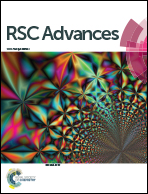Correlation between lipophilicity of newly synthesized ionic liquids and selected Fusarium genus growth rate†
Abstract
The purpose of the present study was to examine the effectiveness of 23 different synthesized ionic liquids (ILs) on Fusarium culmorum and Fusarium oxysporum growth rate. The strategy of IL synthesis was a structural modification of ionic liquids through changing the polarity of imidazolium and pycolinium cations and replacing halide anions with well known antifungal anions (cinnamate, caffeate and mandelate). The findings clearly suggest that the type of alkyl chain on the cation is the most determining factor for IL toxicity. In order to examine how IL structure affects their toxicity towards Fusarium genus, lipophilic descriptor A log P is calculated from density functional theory and correlated with Fusarium growth rate. All these results demonstrate the high level of the interdependency of lipophilicity and toxicity for investigated ILs towards the Fusarium genus. The data collected in this research suggest that the inhibitory influence of ILs is more pronounced in the case of F. oxysporum.



 Please wait while we load your content...
Please wait while we load your content...